

You’ve seen the light: you know that a strong brand can do incredible things for a business. But your boss, on the other hand, thinks a brand is a quick logo whipped up in Canva. If you’re wondering how to explain branding to your boss, and convince them to invest in branding, you’re in the right place. Let’s dive into strategies that speak to leadership priorities, leverage psychology, and make the business case for branding.
Speak Their Language: Money
Before you talk design, talk dollars. Branding is an investment — one that pays off. Here’s how to make the case to invest in branding:
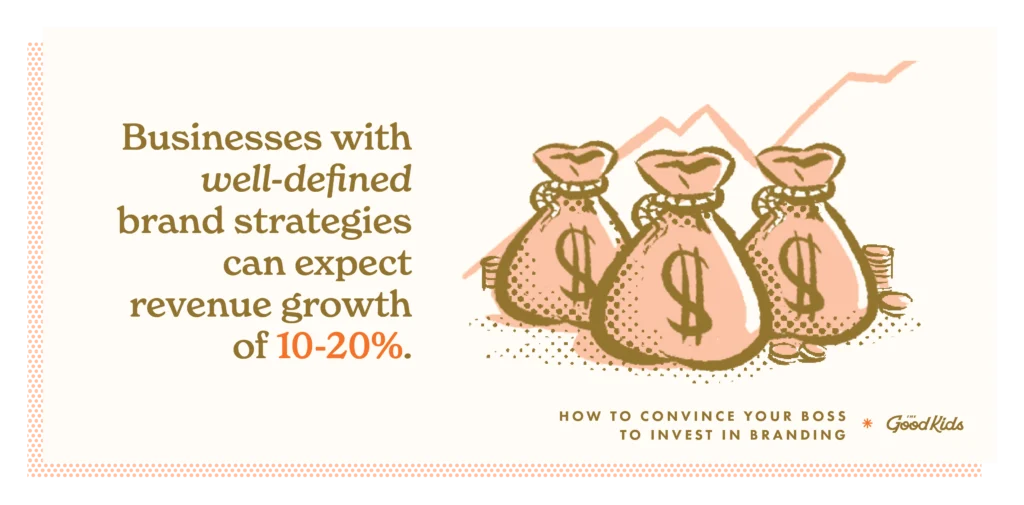
Emphasize the ROI
A professional brand isn’t just nice to have. It contributes to business success. Start by stockpiling some straightforward stats. Don’t feel like searching? We got you.
Marq, formerly Lucidpress, found that businesses with consistent branding tend to experience 33% higher revenue compared to one that struggles with off-brand content. Would your boss consider that a win? Definitely.
Your boss has heard of Harvard, right? Right. Reported by Harvard Business Review, businesses with well-defined brand strategies can expect revenue growth of 10-20%.
If having Forbes on your side will convince your boss to invest in branding, use this statistic: A memorable logo can increase brand recognition by up to 80% (Forbes, 2023).
The statistics above will help move the needle, but in the event that you need more, look no further than our blog on the ROI of Branding. Next up, gather case studies of businesses that invested in branding, and saw measurable results. Need a shortcut? We have some great ones. Focus on companies similar to yours in size or industry for maximum relevance.
Explain the Benefit of Premium Pricing
Well-branded companies can charge more and people happily pay. Strong brands create perceived value that transcends price wars. In fact, according to Motista, customers who are emotionally connected to a brand spend up to two times as much for similar products.
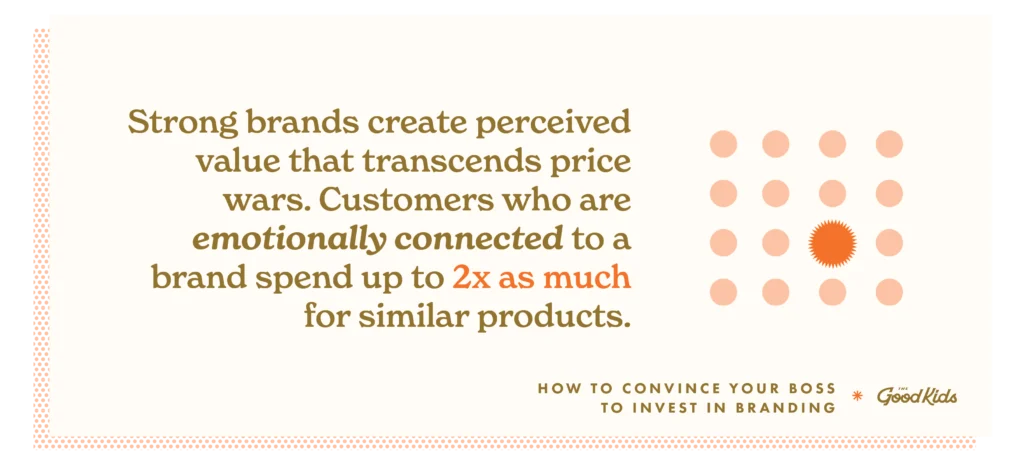
This isn’t just for global giants like Apple or Nike. Small businesses with strategic branding consistently outperform “scrappy” or inconsistent competitors.
Draw Attention to Customer Loyalty
Remind your boss that repeat customers are gold and how branding plays a critical role in that. According to Bain & Company, increasing customer retention rates by just 5% can increase profits as much as 95%. Branding builds loyalty by creating emotional connections that last beyond a single purchase.
When you’re speaking “boss,” don’t forget to tie every branding benefit back to revenue, retention, and market share
Paint a Picture of Brand Disaster
Oftentimes, it’s not enough to show the dream; you have to show the nightmare too.
Spotlight Poor Branding Examples
Gather real-world examples of brands that suffered from inconsistency, confusing messaging, or a lack of differentiation. Find news articles about brand collapses, rebrand disasters, or companies who lost customer trust because they didn’t invest early enough. Need a jumpstart? Check out these examples from Allegrow.
Bust out the Competitor Comparison
Nothing stings like seeing your competitors outshine you. Highlight how the competition is investing in branding: fresher visuals, clearer messaging ,and a better customer experience. Explain that every day spent standing still is a day lost to your competitors.

Create a Montage of Missed Opportunities
Pull together a presentation of the leads, collaborations, PR opportunities, or social engagement the company could have captured — but didn’t — due to an underwhelming brand. Think of it as strategic FOMO: Fear of Missed Opportunities.
Draw from the Data
You don’t need to out-debate your boss. You need to out-data them. If you’re serious about getting leadership buy-in, nothing beats solid proof of why it’s smart to invest in branding now.
Survey Your Customers
Run a simple brand perception survey. Ask customers what three words come to mind when they think of your business, or how your company makes them feel. Numbers will help move emotional arguments into logical territory.
Need a hand drafting the survey? Start with these:
– Name three emotions that come to mind when you hear [business name].
– On a scale from 0-10, how likely are you to recommend [business name] to a friend or colleague?
– What would you tell a friend about [business name]?
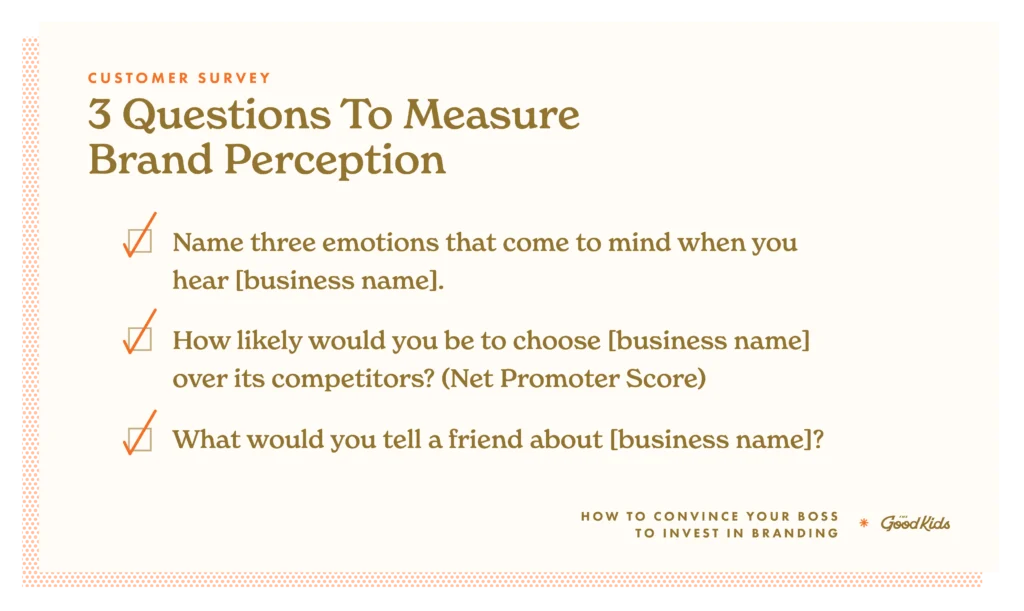
Bring in the Experts
Nothing will sway your boss quite like an expertly-crafted Brand Perception Report, especially when you tell them it was free! The Brand perception Report includes:
- Verbal, Visual, and Interactive Findings
- A Competitive Landscape Analysis
- Key Recommendations
…And it’s sent your way after just seven days.
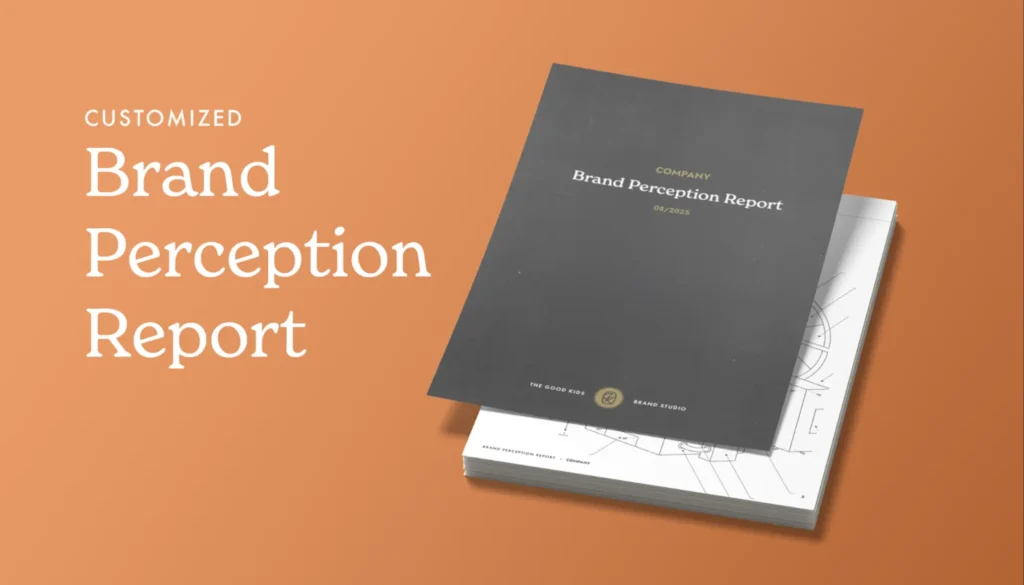
Include Credible Sources
Present information with stats on the impact of branding. We touch on some important stats in this blog post.
The “Everyone Else Is Doing It” Approach
Yes, the logic that worked on your parents can work on your boss too.
Show off the Industry Leaders
Research industry examples of companies that successfully rebranded — especially ones that used branding as a platform for major growth or evolution. (Here’s a couple to get started!)
Show how branding allowed them to:
- Enter new markets
- Raise their prices
- Launch successful new products
- Attract better partnerships or investments
- Expand locations
- Lead their team confidently
- Increase revenue
Lean on FOMO
Subtly imply that the companies who invest in branding today will be the ones shaping the industry’s future — and those who stall will get left behind. You’re not suggesting change for change’s sake. You’re future-proofing!
Let’s get some strong examples for your arsenal, shall we?
1. Casper Mattress: Before Casper Mattress, mattresses were sold in boring showrooms with generic branding. Casper launched with clean design, witty copy, and a sleek DTC model. Their trailblazing spirit took them from zero to $750 million in just four years.

2. Slack: Remember when workplace communication tools were dry and technical (think Skype for Business, HipChat)? That was before Slack! Slack invested early in playful branding with bright colors, and a casual voice, and it paid off – the brand achieved $1.12 billion in its first year.

3. Headspace: Meditation apps were once sterile and academic. Headspace was the first meditation brand to show up on the scene with an approachable, animated brand and a calm, human voice. In 2023, Headspace had an estimated revenue of $195 million.

Highlight New Standards
Branding isn’t a trend — it’s the baseline expectation. Customers, employees, and investors all expect a professional, polished brand experience. Standing still looks out of touch.
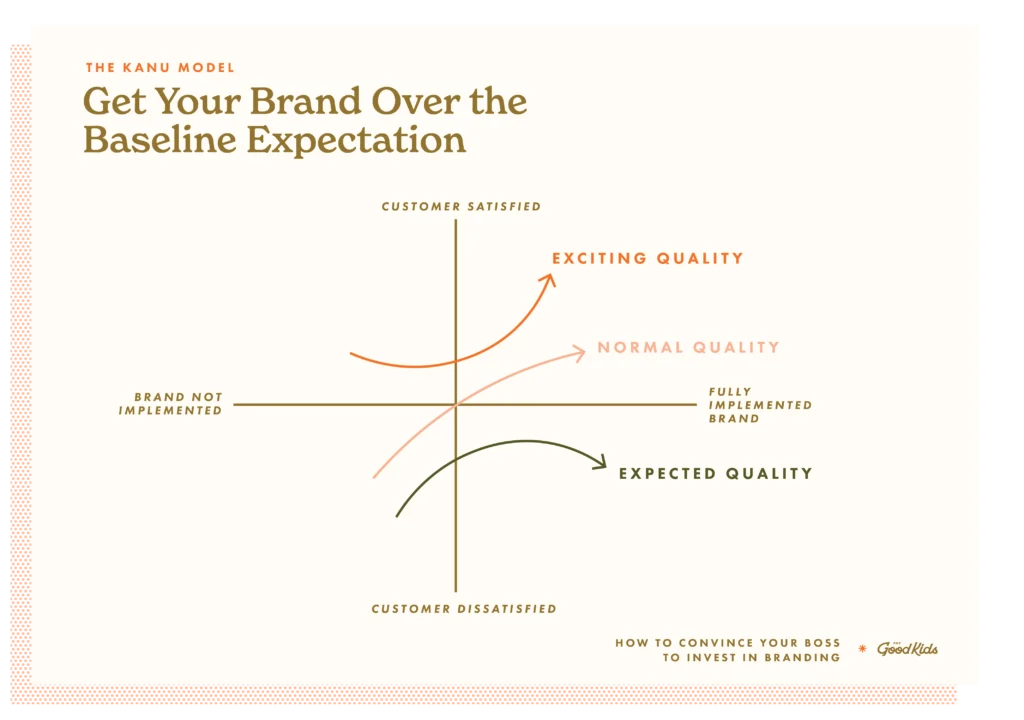
The Cost of Waiting
Sometimes, the biggest risk is standing still.
Explain the Risks of Delaying
Your boss might want to hit pause on branding until “things settle down” or “when there’s a better time.” But while you’re waiting, competitors are pulling ahead, customers are forming first impressions you didn’t shape, and opportunities are slipping by unnoticed.
Explain that delaying brand investment means:
- Losing market share to competitors who are investing.
- Sending mixed signals to potential customers, partners, and employees.
- Missing out on premium pricing, stronger customer loyalty, and brand-driven growth.
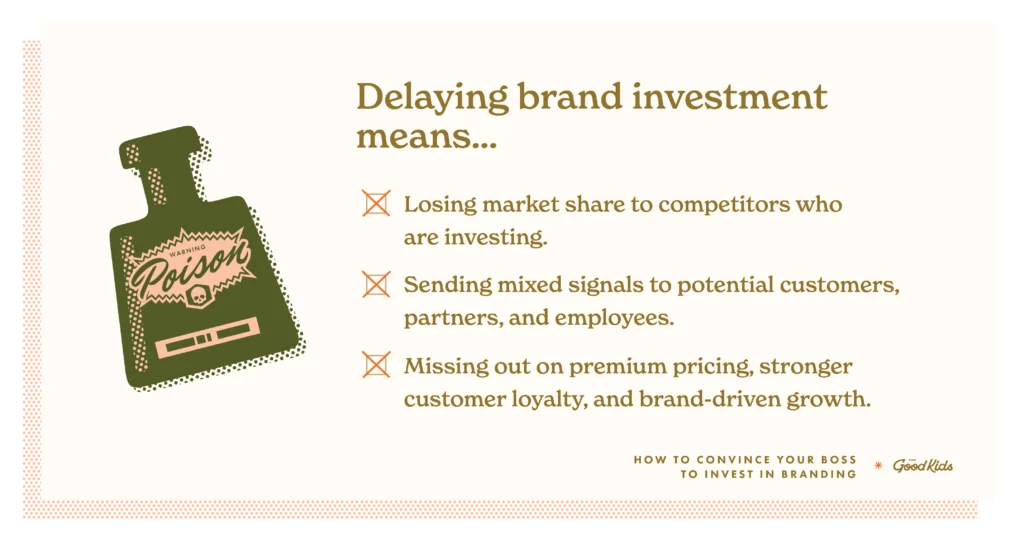
Use the Tree Analogy
You can’t go wrong with a little wisdom.
The best time to plant a tree was yesterday. The second-best time is today.
The Slow and Steady Approach
If your boss is cautious, don’t push too hard. Show them how to test before they invest.
Start Small
Propose a minor branding project as a test run. A Brand Blueprint is an impactful starting point. In just 10 days, you’ll be provided with a deck full of insights on the company, customer, competition and creative. Your boss likes data, remember? They’ll love this.

Show Progress Metrics
Offer to set clear checkpoints so leadership can see results without feeling trapped in a huge commitment. A great place to start? A Brand Audit.
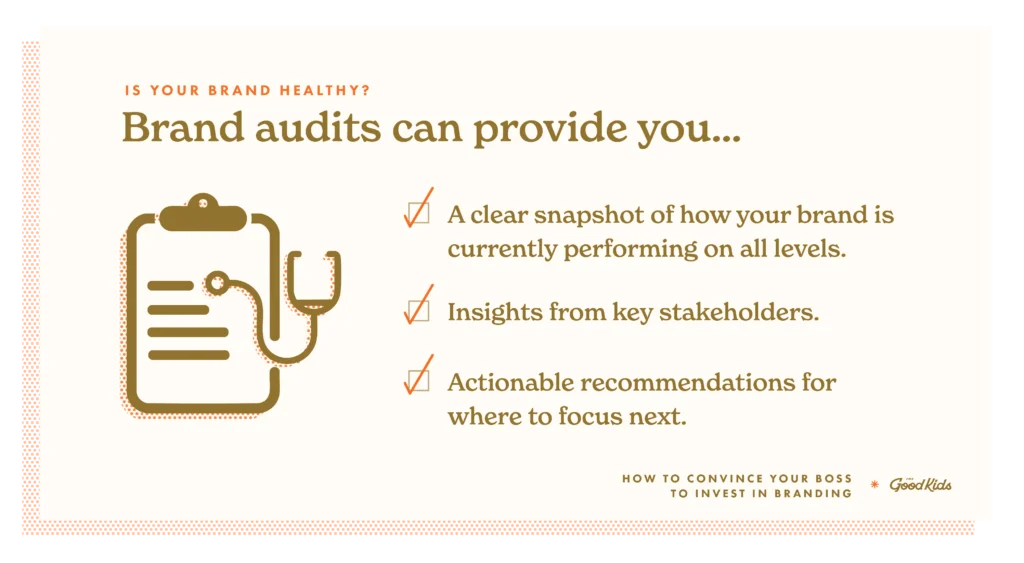
A Brand Audit is essentially a health check-up for your brand. It highlights what’s working, what’s holding you back, and where the biggest opportunities are.
At The Good Kids, our Brand Audits give you:
- A clear snapshot of how your brand is currently performing visually, verbally, and strategically.
- Insights from key stakeholders.
- Actionable recommendations for where to focus next.
It’s a fast, low-risk way to gather real data before making bigger investments. And it gives your boss something they’ll love: a roadmap with measurable next steps.
Make It Personal
At the end of the day, bosses are human too. And humans want legacy.
Have The Legacy Talk
For some leaders, the numbers are important, but what really motivates them is the chance to leave their mark. To be remembered as the person who transformed the business, not just maintained it.
Position brand investment as a defining moment in their leadership story. They’ll be blazing a trail for a strategic move that could shape the company’s reputation, employee culture, and market position for years to come.
Ask them to imagine:
- What do they want people to say about the company 10 years from now?
- How will future leaders describe the chapter they’re writing right now?
- Will they be the person who kept the lights on, or the one who lit the path forward?
Remind them that a strong brand doesn’t just sell products. It builds trust, loyalty, and legacy.

One day, when people look back on this period in the company’s history, the brand they built could be one of the most impactful contributions they made.
Tie It Back To The Vision
Tie branding directly to the future they already want: bigger markets, stronger culture, higher reputation. Branding is the vehicle for that.
Give Them A Personal Brand BoostSubtly hint how a stronger company brand could enhance their personal brand. Who doesn’t want to be the boss who transformed the company image?
The “It’s Not Just Pretty Pictures” Education
Some bosses still think branding = new logo. (Sigh.)
But that’s just the tip of the iceberg…
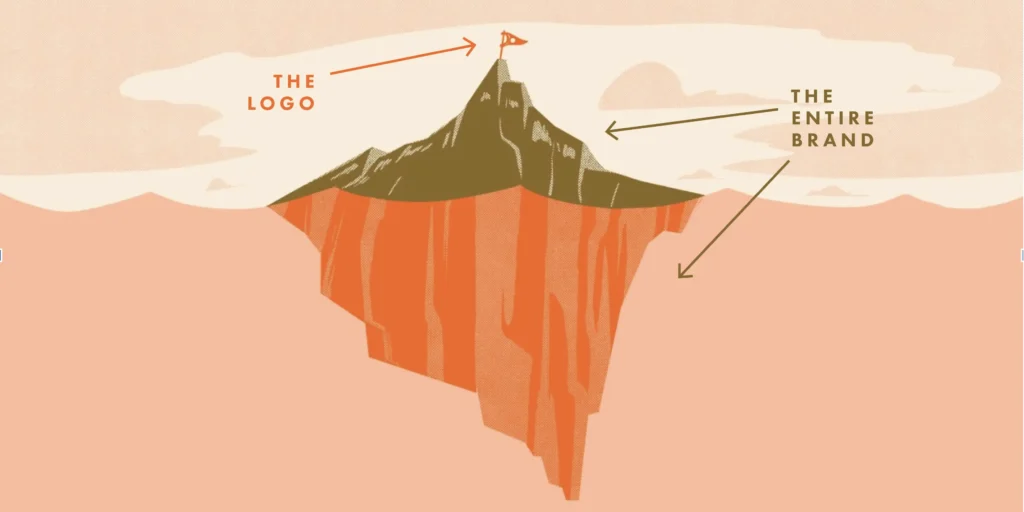
Organize an Internal Brand Presentation
Organize a mini internal session explaining the full scope of branding: strategy, positioning, messaging, customer experience, and identity. Help them see branding as a business tool, not just a design project.
Include Real-World Examples
Pull examples of businesses that shifted customer perception, boosted sales, or expanded markets; all through strategic branding, not visual gimmicks.
Final Word
Turning your boss into a believer won’t happen overnight. But with a combination of data and persistence, it will happen eventually. Just remember: when you know how to explain branding to your boss clearly and confidently, you make it much easier to convince them to invest in branding, and position your company for serious growth.
Stay patient. Keep stacking proof. And when in doubt? Show them our work. 😉


